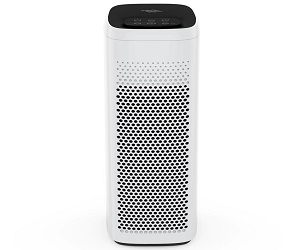Why Does air purifier remove PM2.5?

Users who know a little about HEPA air purifiers must know that in fact, the principle and structure of most air purifiers on the market are not complex, and the main part consists of motors, fans and filters. Work, by the motor to drive the blades to make indoor air to circulate, when the pollutants in the air purifier with an inner the filter, can adsorption on the screen to pass, by a certain time period of repeated operation, so as to achieve the purpose of purifying indoor air, this is the principle of passive filter adsorption type air purifier, It is also the method used by the vast majority of air purifiers on the market.

Formaldehyde Removing.
Filters dominate the efficiency of air purifiers
The number one thing a user needs is to remove PM2.5, so they all get the High efficient particulate air purifier Filter (HEPA) to remove particles from the air. Because it is relatively easy to filter particles with a diameter of more than 0.5μm and less than 0.1μm in the air, and particles with a diameter of 0.1μm to 0.3μm are relatively more difficult to remove. Therefore, the industry defines the HEPA filter level by the filtration rate of 0.3μm particles (this is the same as the KN95 standard mask with the filtration rate of 0.3μm particles).
According to the different filtration efficiency, civil air purifiers mostly use H11 (>98%) ~H14 (>99.997%) level HEPA filter. Of course, it is not that the higher the filtration efficiency of HEPA filter, the better. Because the more efficient the filtration, the greater the wind resistance and the lower the ventilation (requiring more powerful fan motors). When the air volume decreases, the purification times per unit time will also decrease, but the purification efficiency will be reduced.
CADR Value
Therefore, the CADR value (Clean Air Delivery Rate) is introduced into the international standard of Air purifiers to represent the volume of Air that can be purified per unit time. The higher the CADR value, the higher the purification efficiency of the purifier.
Although the best way to remove formaldehyde is ventilation, you can often see the function of air purifier to remove formaldehyde. In the passive adsorption filter type air purifier, this function shows through the filter screen. Formaldehyde itself is also a gas, so HEPA filter can not work at this time, but by adding another layer of activated carbon filter, through the adsorption of formaldehyde to remove formaldehyde.
In many application scenarios, the need to remove formaldehyde in a closed environment is also a big demand of users, so the removal of formaldehyde has also become a hot demand for air purifiers. But this also has disadvantages, because we all know that the adsorption capacity of activated carbon is an upper limit, after reaching saturation can no longer continue to adsorption (but usually the release of formaldehyde is a very long-term continuous process), but may bring secondary pollution. Is there a solution?
An active air purifier works better, and photocatalysts are hot spots
Different from the passive adsorption type, the active purifier eliminates formaldehyde, bacteria, viruses, and other harmful substances through decomposition. Photocatalyst technology is one of the hot active purification technologies at present. Photocatalyst is a general term for photocatalytic photo semiconductor materials. Its role is similar to the catalyst, so it does not participate in the reaction itself, so there is almost no loss, and there is no need to worry about the problem of consumables.
Currently, most photocatalysts on the market use nano-sized titanium dioxide, coated on the surface of the substrate. Under the action of ultraviolet light and visible light, it can produce a strong catalytic degradation function, and degrade toxic and harmful gases in the air (such as decomposition of formaldehyde and TVOC into water) carbon dioxide). At the same time, it can effectively kill a variety of bacteria (strong oxidation to destroy cell membrane and solidify virus protein to achieve the function of killing bacteria).
Conclusion
The traditional photocatalyst mostly uses an iron substrate to place titanium dioxide, and the illumination energy is mostly provided by ultraviolet rays of 180nm/254nm wavelength. This combination is relatively modest, and UV rays at this wavelength risk skin burn and ozone production. In recent years, Japan’s MaSSC photocatalyst technology is emerging. It uses aluminum base material with better efficiency and 365nm wavelength ultraviolet light, which makes the light radiation safer and is not easy to generate a large amount of ozone. To know more on the trustblog!




